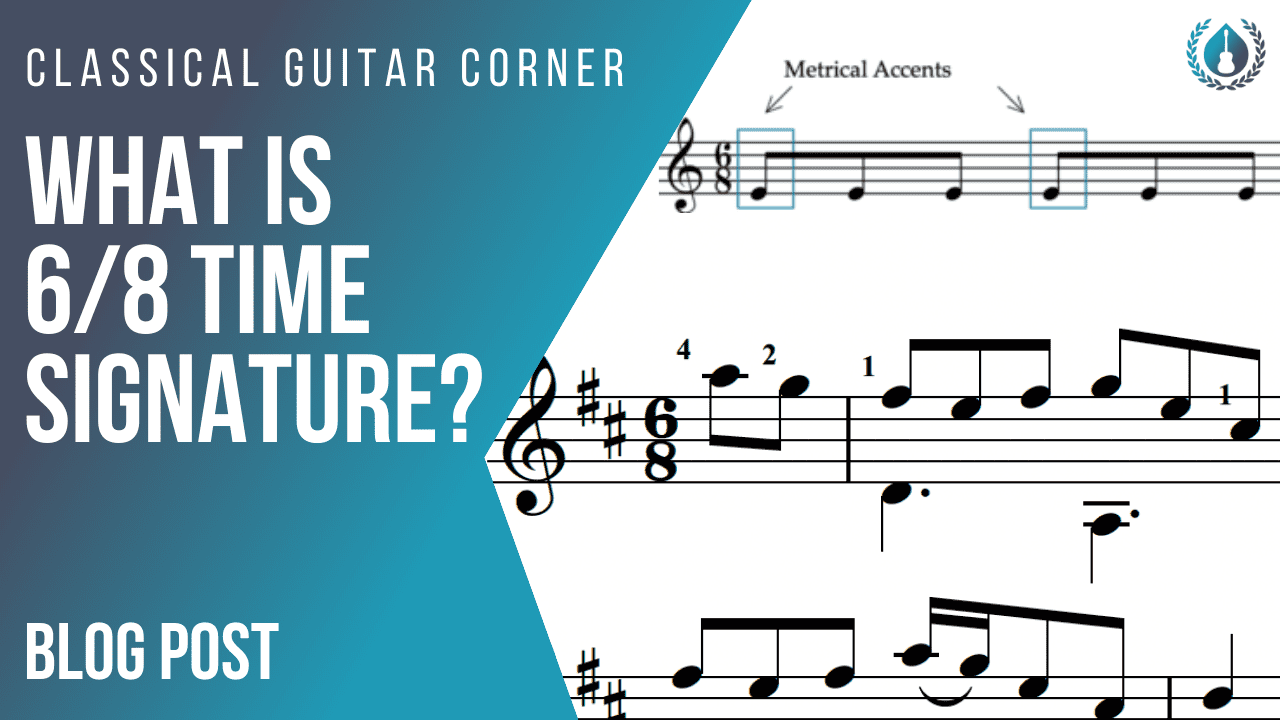Many of the most well-known pieces of music on classical guitar are in 6/8 time signature. If time signatures are new to you, don’t worry, we’ll cover that below. So what is 6/8, what makes it different from 3/4 time, and why does it matter?
Rhythm
Rhythm is one of most essential elements of music (together with pitch, melody, harmony, and timbre). It organizes the various pitches in our music and thus helps us follow along through time. In a technical (and perhaps simpler) sense, rhythm tells us how long each pitch lasts.
Notes
And there are different kinds of rhythms, which we call notes. At the most basic level we will deal with the following kinds of notes, or rhythms:
- Whole note
- Half note
- Dotted quarter note
- Quarter note
- Eighth note
- Sixteenth note
But in a more general sense, rhythm is an umbrella term (like “pitch”) that includes within it the concepts of beat, subdivision, meter, time signature, tempo, syncopation, and more.
Measures
In order to give a clear, easy-to-follow structure to the music, most pieces of music contain measures (or bars) that set boundaries for how many beats of rhythm can be played. Every measure ends with a line through the staff called a “bar line,” like this:

Time signature
But how do we know how many notes or beats to count in each measure? This is where the time signature comes into play, which is simply a tool to help organize the beats in a measure. The time signature has two parts: the bottom number tells us what kind of note to count in each measure and the top number tells us how many notes to count. So, if we have a 4/4 time signature, we will count four quarter notes. 3/4 time signature would be three quarter notes, and so on. Thus, when we talk about 6/8 time signature, we’re referring to rhythms of six eighth notes in a measure.
Meter
Composers group these rhythms (or notes) together into patterns that help us make more sense of them, which we call “meter.” This is not unlike the way we might group numbers mathematically to help us solve equations more easily.
Duple, triple, and quadruple meter
There are three forms of meter: duple (groups of two), triple (groups of three), and quadruple (groups of four). We then divide each of these into either simple or compound meter.
Beaming
And one clue in the music for these groupings is the way a piece of music beams notes together (specifically eighth and sixteenth notes). For instance, in 3/4 time we might beam eighth notes like this, dividing the three equal quarter-note beats into two eighth-note groups each.

In 6/8 time, however (which has the same number of eighth notes), we will group eighth notes into two groups of three. We’ll look at this more closely below.


Time signature vs. Meter
The terms time signature and meter are sometimes used interchangeably. However, they are slightly different from one another. In the most general sense, the time signature simply refers to the symbol used to help us organize the beats in a measure (telling us how many of each kind of beat to expect). Meter, however, helps us group the beats into easily recognizable and recurring patterns.
Simple vs. compound meter
Simple meter
Again, meter is about how notes are grouped to form certain patterns. A “simple” meter is any meter where the “big beat” can be divided into two equal parts. Thus, 4/4 time consists of four quarter notes: each of those quarter notes divides into two, equal eighth notes.
Compound meter
However, a “compound” meter results when the “big beat” divides into three equal parts. In 6/8 time, there are two dotted quarter notes per measure, and each of those divides into three equal eighth notes.
6/8 vs 3/4 time
Mathematically 6/8 time has the exact same number of eighth notes as does 3/4 time. So what’s the difference between them? Here meter becomes very important as the way we group these six equal eighth notes together makes all the difference.
Beam me up, Scottie
Let’s take a look at one measure of 3/4 vs. one measure of 6/8, focusing especially on how the notes are beamed or grouped in each one.

As you can see 3/4 groups the eighth notes into three equal groups of two, while 6/8 groups them into two equal groups of three. But this grouping pattern of the different meters doesn’t just affect how the notes look, it affects the way the music feels.
Tempo
An important consideration in the difference between 3/4 and 6/8 time is tempo. Too slow of a tempo for 6/8 can also affect the feel and it becomes hard to tell the difference with 3/4. Likewise, too fast of a tempo for 3/4 can often feel more like 6/8. Thus, it’s important to choose tempos that reflect the accents that make up each meter. (Go here to learn more about tempo markings in classical guitar music)
Metrical accents
2/4 meter
Every meter has certain accents that help you “feel” the meter. For instance, in 2/4 there is a natural accent on beat 1 and a slightly weaker accent on beat 2. There’s a natural walking feel to this meter, and so it’s often associated with the march. Think of the military drill sergeant leading a soldier’s march: “Left-right! Left-right…!”
3/4 meter
Likewise in 3/4 we have natural accents on beats 1, 2, and 3 where 1 is strong and 2 and 3 are a bit weaker. That feel of strong-weak-weak or “boom-chuck-chuck” is the natural feel of the waltz dance. And so many waltzes are written in 3/4 time.
6/8 meter
In 6/8, however, which is a compound meter, the accents fall on beats 1 and 4 (again with 1 being slightly stronger than 4). Those two “big beats” or accents in the measure gives us the sense of swaying back and forth, like a boat rocking on the waves. Again, a barcarolle (which is a boat song) is often written in 6/8 time and has this same feel of swaying back and forth on beats 1 and 4.

What songs are in 6/8 time signature?
Many of our favorite classical guitar tunes are written in 6/8. And most of them carry with them that feel of swaying back and forth. Before we get to those, you might consider a popular nursery rhyme to help you get the feel.
The Farmer in the Dell
The Farmer in the Dell is a great example of 6/8 time. What’s great about this tune is not only that it is so universally familiar but also that the melody is structured to help us feel those bigger beats of 1 and 4. If we count 6/8 like this: 1-2-3, 4-5-6 (with a stress on 1 and a slightly weaker stress on beat 4) then The Farmer in the Dell would count like this:
6 (The)—1 (Far-), 3 (-mer)—4 (in), 6 (the)—1 (dell)
Short-long metrical accents
Placing short notes (eighth notes) before the longer ones (quarter notes) offers a natural stress on those longer quarter notes. Thus, the melody of the rhythm helps us feel the metrical accents of 6/8. Classical guitar composers use similar rhythmical and melodic devices to aid the listener and help us feel 6/8.
Here are some examples of 6/8 in classical guitar music:
Agustín Barrios, Julia Florida
Fernando Sor, Estudio in D, Op. 31 No. 3
Jorge Morel, Sonatina (mvt 3, Allegro)
Hemiola
Sometimes a composer may choose to intentionally play upon the similarities between 6/8 and 3/4 time with a device known as hemiola. Hemiola essentially alternates between a feeling of “3” with a feeling of “2.” As we saw above, 3/4 has three metrical accents while 6/8 has two. Because each meter has the same amount of eighth notes per measure we can switch back and forth between 6/8 and 3/4 to give a dynamic feel to a piece of music.
Horizontal hemiola
A great example of this is in Gaspar Sanz’s “Canarios.” Throughout the piece Sanz changes between 6/8 and 3/4 (usually ending phrases or mini-phrases with 3/4). It gives the dance a wonderful vitality.
Gaspar Sanz, Canarios
Vertical hemiola
Canarios is a wonderful example of horizontal or sequential hemiola, but we can also have a vertical hemiola, where 6/8 and 3/4 are superimposed on top of one another. Here we enter the realms of syncopation and polyrythms, which can get quite advanced and challenging. Here’s a perfect example:
Javier Contreras, Tonada al Retorno
Wrapping up
We hope you’ve enjoyed this deep dive into 6/8 time and have a better understanding of what it is, what the difference is between 6/8 and 3/4 time, and what kind of pieces it appears in. Let’s review quickly:
- 6/8 time signature has six eighth notes in each measure
- It’s in compound meter, with two large groups of three eighth-note beats each
- Thus, it has a feel of two “big beats” with accents on beats 1 and 4, while 3/4 has a feel of three “big beats” with accents on 1, 2, and 3
- 3/4 and 6/8 can alternate or even overlap to create a hemiola rhythmic effect
***
As you get more familiar with 6/8 time signature you’ll notice there are many classical guitar pieces that feature it. We’ve created a Quick-Start Guide below that you can download with a selection of great classical guitar pieces in 6/8 time signature, including some that feature hemiola!


Not to be too picky, but a drill sergeant would say, “LEFT, right, LEFT, right…”. Marching leads with the left foot (at least according to the US drill manuals).
Thanks, Steve! Clearly I’ve never been in a drill sergeant’s march!! Will fix that now. :)
Peace,
Dave B (CGC team)
[…] Spain. The Canarios dance alternates 6/8 with 3/4 time signatures using a technique known as “hemiola.” Thus the accent of the dance changes, which is quite challenging. Below you can listen to a […]
[…] 6/8 time signature is a compound time signature. This means that each beat is divided into three parts rather than […]
Hi Dave,
Thank you for this blog post. Wow, ‘vertical’ hemiola, this was completely new to me. In one of the past CGC workshops on rhythm, which I was re-watching last month, Simon mentioned that we could spot a hidden hemiola in Sor Estudio in D, Opus 31 no. 3, towards the end of the piece. We do not know whether Sor intended it that way or not, but I am having fun playing the corresponding passage with the hemiola spirit since then.
Thank you,
Aiko
Hi Aiko,
Best wishes as you explore the hemiola spirit!!
Peace,
Dave B (CGC team)
I still can’t get my head round time signatures 😭
Hi Jim,
Was our guide useful for you? What do you get stuck on with time signatures?
Peace,
Dave B (CGC team)
Very helpful advice regarding, what can sometimes seem like, an unfathomable area of music theory. Thankyou so much 👍💫🎶
Thanks for your kind words, John! Glad the article was helpful!
Peace,
Dave B (CGC team)